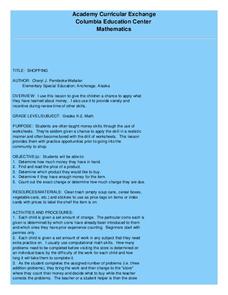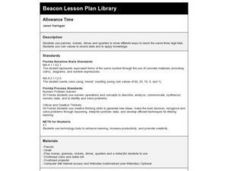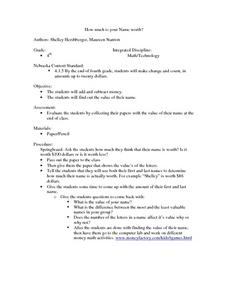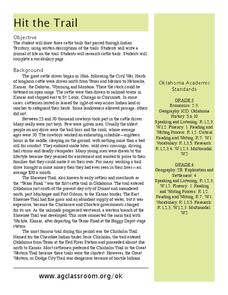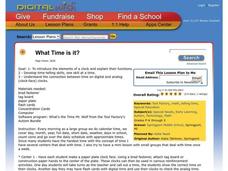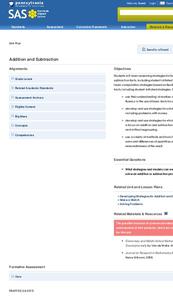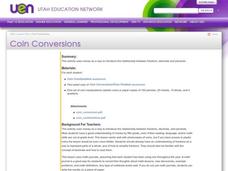Curated OER
Shopping
Students determine how much money they have in hand, find and read the price of a product, determine which product to buy, determine if they have enough money, and count out exact change or determine how much change is due.
Curated OER
Allowance Time
Students complete a worksheet in which they determine ways of using coins to make the value of $1.00.
Curated OER
How Much is Your Name Worth?
Students identify the value of each coin type and then use a code to assign each letter of the alphabet to the value of the coins. They add coin combinations to determine the value of their name.
Curated OER
Problem Solving
Sixth graders solve problems involving money at learning situations. They solve the problems and determine if there is a solution, one solution, or many solutions. They write problems that have more than one solution and incorporate...
Curated OER
A Penny for Your Thoughts
Students collect pennies to donate to Kiwanis International for their international effort to buy salt for children's bone development. They calculate the amount of money donated, calculate how many children will receive salt, and write...
Curated OER
Budgeting - The Basics, Part 1
Students investigate personal budgets and discuss how to make monetary decisions. They work in small groups to make money decisions for their classrooms or a playground, and present their decisions to the whole class.
Curated OER
Probability or Ability?
Young scholars toss candy and coins using their non-dominant hand while their partners records the results on a probability charts.
Curated OER
The Power of Compounding
Sixth graders examine the concept of compounding interest on invested money. They explore how much interest their money would earn through compounded interest. Students conclude that they should invest early and often.
Curated OER
Benny's Pennies
Students read Benny's Pennies and predict what Bennie will buy with each penny based on the illustrations. They locate rhyming words and make a chart of what Benny bought and also for what they would have bought.
Curated OER
What Did It Cost 100 Years Ago?
Students compare prices of good across the century in order to introduce the topic of inflation. They undertand the concepts of inflation and Consumer Price Index (CPI), use online calculators to figure the approximate cost of goods...
Curated OER
How Do You Profit From Trading Stocks?
Students calculate gains and losses of stock portfolios. Although the Global Stock Game (GSG) calculates profits and losses automatically, students should learn the basic math skills in calculating their stock investment the...
Curated OER
Team Apollo
Seventh graders brainstorm about problems with a school track. They research different possibilities for a solution. They test different track materials with erosion, durability, abrasiveness and resiliency. They determine the area,...
Curated OER
Micro-finance Challenge
Students play a micro-finance game. in this global economy lesson, students play a game that assists them in concepts of micro-finance. Students will also watch a business development video and explore additional resources.
Curated OER
Hit the Trail
Students read about the history of cattle trails and complete language arts, math, social studies, and more activities about barbed wire. In this barbed wire lesson plan, students read poetry, research changes over time, draw cattle...
Curated OER
Penny, Nickel, Dime
Second graders recognize and compare the value of pennies, nickels, and dimes. They review counting pennies, nickels, and dimes.
Curated OER
Planning A Household Budget
Students experience real life by utilizing math skills to plan a household budget and enhance their financial planning skills.
Curated OER
Leaves, Flowers, Seashells, Mirrors and Symmetry
Students develop an understanding of patterns and symmetry. In this symmetry and pattern lesson, students use real world patterns then analyze and extend them. Students also use real world items while discovering and observing symmetry.
Curated OER
What Time is it?
Pupils participate in three centers focused on developing time-telling skills. In this time instructional activity, students create their own paper plate clock face, play "Time Concentration" using times on the hour and half hour, as...
Curated OER
Addition and Subtraction
Young scholars develop their own strategies to solve basic addition and subtraction facts. In this addition and subtraction lesson plan, students use strategies they already know and new ones to solve problems.
Curated OER
Coin Conversions
Fifth graders engage in the study of conversions from decimals to percents while examining monetary values. They explain the relationships between the equivalency interchanging decimals with percents. Then students write about the...
Curated OER
Using the Calculator (Part II)
First graders watch a demonstration by their teacher to see how to use a calculator. They identify the numbers being used and input them into the calculator. On a worksheet, they record the answer and use coins to show the total.
Curated OER
Using The Calculator
First graders use a calculator to total money quantities. They use plastic coins to represent the cost of an entire purchase. Students model specific dollar amounts and how to make change.
Curated OER
Matching Pairs
Learners take turns matching the appropriate shapes (listing coin values) to those with numerical values listed on them. When students are successful, they win a blank shape for their collection.
Curated OER
Greece Adopts the Euro
Pupils examine the European Union and how it adopted a single currency, the Euro. They research a number of websites to explain the Euro and its current value.


